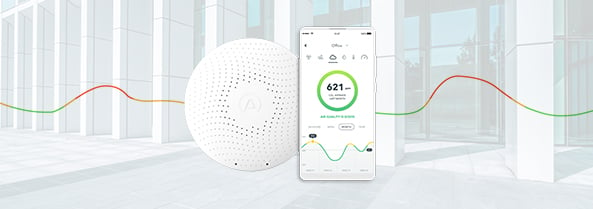Facility Managers and HVAC professionals sometimes feel there are barriers to adopting indoor air quality monitoring. The rewards of overcoming those barriers and adopting this cutting edge tech are increasingly worth it.
Although outdoor air pollution has been widely discussed for some time, we are now becoming aware of the potential health risks of poor indoor air quality in our daily lives. Public health agencies stress the importance of knowing about the air we breathe, and the World Health Organisation (WHO) emphasizes the role of indoor air pollution in driving up the global burden of disease.
The message is now starting to filter through to customers, who are beginning to install indoor air quality and radon monitors in their homes in increasing numbers. Our research shows that they’re taking action, for example by improving ventilation and choosing toxin-free cleaning products.

Despite this heightened awareness, the majority of offices and schools across the globe are still not monitoring indoor air. For example, there is no federal legislation in the US relating to radon levels and testing in schools. Only 9 US states have local regulations, but even then the stringency of such testing varies considerably from one state to another. In other words, not enough is being done.
For decades, we’ve known about the potential effects of outdoor pollution. However, science shows that concentrations of many of the worst pollutants are up to five times higher indoors. Given progress on delivering cleaner outdoor air seems so slow, should we be discouraged about the prospects of tackling indoor air quality successfully?

Our experts believe that there are solutions that can provide everyone with the indoor air quality they deserve, and these solutions are more important than revolutionary tech. Facility Managers and HVAC pros can help deliver on these simple steps, but the key is having information about the air we breathe.
Many of our conversations about air quality are dominated by talking about global warming and outdoor pollution, but we need to have equally important discussions about our indoor air quality, such as radon (a radioactive gas that is emitted by rocks and soil), VOCs (potentially health-damaging gases emitted by household products), CO₂, temperature, humidity, and air pressure levels. These factors have real consequences for employees’ productivity and comfort, as well as their health.
We’ll show that focusing on indoor air quality offers a better return on investment (ROI) than narrower conversations about energy efficiency. We’ll examine the barriers and challenges to adopting this tech, discuss how they can be overcome, and assess the rewards of improving indoor air quality for everyone.
Indoor air quality's global health impact: The figures

Outdoor air dominates public discussion about air quality, but the US Environmental Protection Agency estimates that concentrations of key pollutants are 2 to 5 times higher indoors than outdoors. According to the World Health Organisation (WHO), indoor air pollution is responsible for 2.7% of the burden of disease globally.
To put that figure into context, it means that 1.4 million people are dying each year because of illnesses caused by poor indoor air quality. The numbers have gone up in recent decades because of increased use of synthetic building materials, air-tight properties, pesticides, and household cleaners.
The State of Global Air survey (SOGA) found that ambient and household air pollutants are together responsible for cutting 2 years and 6 months from the average person’s life expectancy.
In the shorter term, indoor air quality has a pronounced effect on performance among building users. A study by Harvard T.H. Chan School of Public Health and United Technologies Climate revealed that improved indoor environmental quality could boost decision making scores by 101%.
Indoor air monitoring: What does it measure?
Airthings for Business Indoor air quality monitors give you full visibility into 6 sensors that affect indoor air quality:


- Humidity
- Temperature
- Pressure
Monitoring the indoor air quality can provide information on levels of radon, a radioactive gas that is emitted by rocks and soil, and is responsible for an estimated 15,000 – 22,000 lung cancer deaths among non-smokers in the US each year. An indoor air quality monitor measures TVOCs, or total volatile organic compounds – which are potentially damaging toxins and chemicals contained in cleaning products, paints, solvents, carpets, and furniture. The damage these chemicals cause to an occupant’s health has been named ‘sick building syndrome’.

Indoor air quality monitors can also read carbon dioxide (CO2) levels. Exposure to CO2 can result in reduced productivity, poor decision making, and increased drowsiness; and can impact absenteeism and your bottom line.
Additionally, Airthings sensors monitor conditions such as humidity and temperature, which are some of the most complained about air quality factors in office environments. Add conditions such as headaches from increased pressure levels to this list, and you can clearly see why cumulatively they affect our health and influence how well we perform day-to-day tasks.
The barriers and challenges to adopting Indoor air monitoring tech

For Facility Managers (FM):
FMs are asked to master an ever-evolving range of responsibilities, shaped by changing legislation and compliance rules, against a backdrop of budget cuts. The challenge of introducing new tech, with the added pressures of crunching more data and actioning it, can seem daunting.
Indoor air quality monitoring often uncovers a need for better ventilation in a building, which can seem like a headache for FMs in an age of energy-efficient, air-tight buildings. You may feel like you’re being bombarded with contradictory information, but there is a growing need to become user-led rather than building-led, in order to provide the best environment for occupants.
If indoor air quality monitoring shows a problem, naturally it can be a cause for concern for the property owner who feels they’re responsible. Any assets need to be installed and maintained, and some systems require wiring, making the process messy and time-consuming. In addition, it can be difficult to untangle the costs of tech, over its life-span, or on a month-to-month basis.
FMs need to demonstrate that new equipment will offer a return on investment and productivity gains, and they’ll need the data to back that up. The assets must be easily installed, and there has to be evidence that they’re safe and working properly.
For HVAC pros:
If you’re in HVAC, your customers are probably aware of the importance of air-conditioning, but they’re less likely to know much about indoor air. The prospect of adding more units to their installation may set off alarm bells.
HVAC is a particularly competitive industry, mixing new tech and traditional solutions. Ventilation is a major investment for your clients, often requiring a lengthy decision-making process, with big questions about economizing on energy.
That puts you under pressure to differentiate your solutions from the competition. It can be difficult to help customers see the bigger picture, so they’re taking into consideration more than just temperature and CO₂ when they’re thinking about HVAC.
New tech will provide critical insights into levels of radon as well as indoor air quality. Wireless, battery-operated systems can be easily and quickly installed and consume very little energy to operate. The key is helping customers understand how integration and insights will add value to their business, producing better results and a better ROI, in the long-term.
Overcoming the barriers to deliver results

In order to increase adoption of this tech, it’s vital for HVAC providers to identify the benefits of systems that integrate indoor air quality.
It helps that awareness is growing into how a healthy indoor air environment can boost the performance of workers. A study co-authored by the Harvard T.H. Chan School of Public Health calculated that cognitive improvements from better quality air resulted in each employee generating on average $17,000 more each year.
A 2018 report by the World Green Building Council suggested a healthier work environment could cut sick leave by 58%, or 4 days per year per employee.
By including indoor air quality monitoring alongside a ventilation system, HVAC pros can differentiate their product, demonstrating productivity gains and easier installation. The latest tech uses wireless equipment, offering long battery life and remote access, that can be integrated with other systems, using communication software called APIs.
For FMs, these systems provide evidence that can enable them to resolve issues with radon, VOCs, CO2, humidity, temperature, or pressure. Indoor air offers a route to increased ROI and productivity by providing a better environment for tenants and building users.
Takeaways
- Indoor air quality has a major impact on public health, with concentrations of some of the worst pollutants up to five times higher indoors.
- Indoor air quality monitoring can measure levels of contaminants like radon, TVOCs, and CO2, as well as gather information about humidity, temperature, and pressure.
- For FMs, new tech raises questions about data overload, ROI, and productivity, for which they require evidence.
- HVAC pros may encounter a lack of awareness about the benefits of indoor air quality monitoring.
- The right solution helps create happier, more productive building users, through tech that is easy to install and easy to maintain.

 Most popular
Most popular
 NEW
NEW




 Radon
Radon
 Radon
Radon










